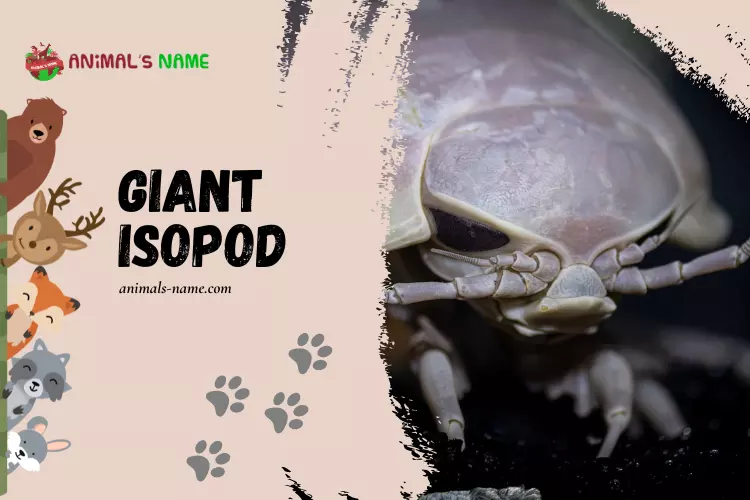Have you ever heard of the Giant Isopod? It is a fascinating creature that dwells in the depths of the ocean. In this blog post, we will explore this intriguing animal’s history, facts, size, habitat, and classification.
The history of the Giant Isopod can be traced back to the late 19th century when it was first discovered by the famous French naturalist Alphonse Milne-Edwards. Since then, scientists have been captivated by this unique specimen. The Giant Isopod belongs to the category of crustaceans, similar to crabs and lobsters.
As the name suggests, the Giant Isopod is indeed enormous. It can grow to approximately two and a half feet, making it the most enormous known isopod in the world. Its appearance is quite peculiar; its tough exoskeleton protects its body, which is segmented into various parts.
The habitat of the Giant Isopod is the deep sea, residing at depths of up to 7,000 feet below the surface. In the cold and dark waters, it roams the ocean floor, scavenging for food. Its diet mainly consists of dead fish, squid, and other ocean animals that sink to the depths.
Regarding classification, the Giant Isopod belongs to the genus Bathynomus, with two known species so far. These fascinating creatures are part of the diverse animal kingdom and have amazed researchers with their adaptability to extreme conditions.
This blog strives to provide exciting and educational content about various animals. Don’t forget to check out our article on 155+ Animals Name. Now, let’s delve further into the incredible world of the Giant Isopod—the history, facts, size, habitat, and classification of this fascinating ocean dweller.
History of Giant Isopod
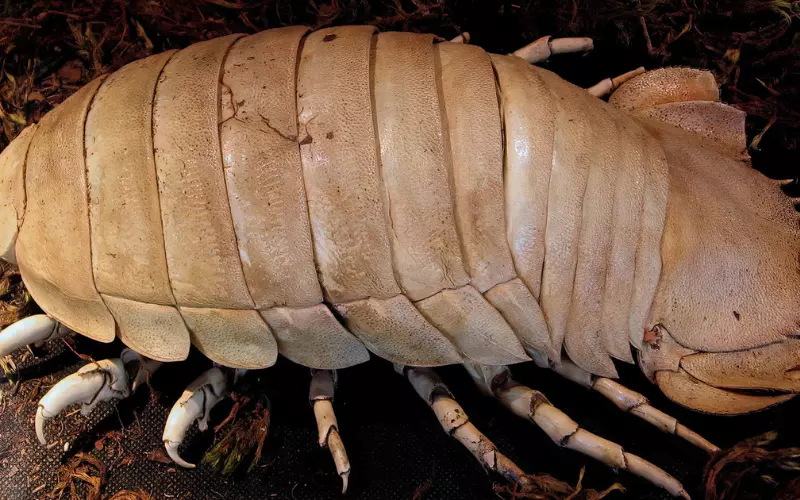
The giant isopod is an intriguing creature that has a remarkable history. These unusual animals are members of the crustacean family and can be found in the deep waters of the Atlantic, Pacific, and Indian Oceans. They were first discovered in 1879 during an expedition in the Gulf of Mexico. Since then, scientists have been fascinated by their unique characteristics and survival abilities.
Giant isopods have a long evolutionary history that dates back millions of years. Fossils of their ancestors have been found, showing that these creatures have been around for a very long time. They have adapted to living in the dark depths of the ocean, where there is extreme pressure and little food. One of their incredible adaptations is their ability to go without eating for long periods. This allows them to survive in their harsh and challenging environment.
These fascinating creatures have also played a role in scientific research. Due to their ability to withstand high pressures, they have been studied to learn more about the effects of deep-sea conditions on living organisms. Scientists have also discovered that their blood contains a unique substance that is useful for detecting the presence of bacteria. This discovery has been valuable in the field of medical research. Overall, the giant isopod’s history is a testament to its resilience and adaptability to the deep-sea environment.
Importance of Giant Isopod
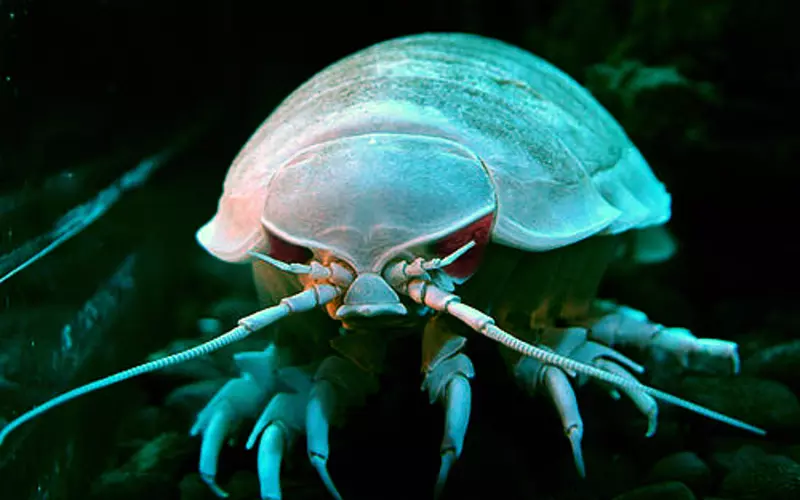
The Giant Isopod is a vital animal in our oceans. First, they play a crucial role in the ecosystem as part of the scavenger community. They are the cleaners of the sea, feeding on dead animals and helping to keep the ocean floor clean and free from rotting remains. Without Giant Isopods, the ocean would be filled with decaying matter, leading to imbalances and harmful effects on other marine life.
Secondly, studying Giant Isopods is essential for scientists to understand the ocean’s health. Due to their habitat preferences and sensitivity to changes in water conditions, these creatures can serve as indicators of the overall marine environment’s health. By monitoring the population of Giant Isopods, scientists can gain insight into the impacts of pollution, climate change, and other factors that affect the underwater ecosystem.
Lastly, Giant Isopods spark curiosity and fascination in people. They are extraordinary creatures with their unique appearance and behaviours. By learning about them, we can appreciate the diversity of life on Earth and the wonders of the deep sea. This understanding can inspire us to protect our oceans and all the marvellous creatures that inhabit them.
The Giant Isopod’s importance lies in its role as a scavenger, its ability to indicate the health of the marine environment, and its ability to ignite curiosity and wonder. By recognizing their significance, we can strive to protect the Giant Isopod and the oceans they call home.
Amazing Facts About Giant Isopods

1. Giant isopods are crustaceans that belong to the same family as woodlice and shrimp.
2. They are the largest known isopod species, with some individuals measuring over 16 inches in length.
3. Giant isopods have a unique appearance: a robust body, a flattened shape, and a rigid exoskeleton that protects their soft internal organs.
4. These fascinating creatures can be found in the deep sea, typically at depths of around 550 to 7,020 feet.
5. Unlike their smaller relatives, giant isopods have a much longer lifespan, living for up to 5 years in the wild.
6. Giant isopods are opportunistic scavengers, feeding on dead fish, squid, and other marine animals that sink to the ocean floor.
7. They have adapted to survive in the harsh and dark deep-sea environment by having a slower metabolism than their shallow-water relatives.
8. These isopods possess strong jaws that allow them to break through the tough skin of their prey or scavenge food.
9. Giant isopods have compound eyes that are relatively small and less efficient than the eyes of their shallow-water counterparts.
10. They also have sensory appendages called antennae, which help them navigate and perceive their surroundings.
11. These creatures have a unique ability to survive in oxygen-poor environments, as they can switch to anaerobic respiration when necessary.
12. Female giant isopods carry their eggs in a special brood pouch called a marsupium until they hatch into juvenile isopods.
13. The larvae of giant isopods are planktonic, drifting in the water column until they become adults and settle onto the ocean floor.
14. Giant isopods have few natural predators due to their large size, tough exoskeleton, and deep-sea habitat. However, some deep-sea fishes and cephalopods may prey on them.
15. These fascinating animals have become popular in aquariums, where they are displayed to educate the public about the diversity of marine life in the deep sea.
Can we keep Giant Isopod as our Pet?
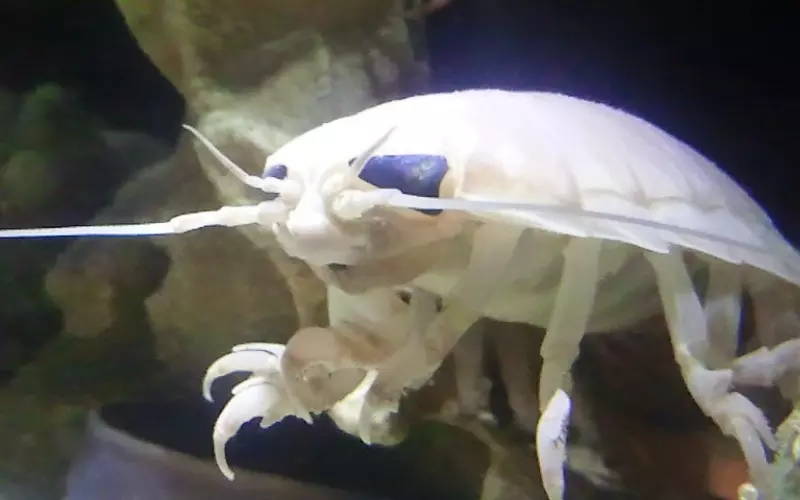
Giant Isopods are fascinating creatures that live deep in the oceans. They have a unique appearance with rigid, armoured bodies and many legs. However, it is not recommended to keep Giant Isopods as pets. These animals are not suitable for domestication due to various reasons.
Firstly, Giant Isopods require a specific habitat to survive: the deep sea. We can’t recreate this environment in our homes or aquariums. They need high water pressure, low temperatures, and darkness to thrive, which are difficult to replicate. Keeping them in a domesticated setting would not only be incredibly challenging but also inhumane, as they would not be able to live happily and healthily.
Moreover, Giant Isopods are not commonly found and are considered rare. Reports are suggesting that they might be facing extinction. Their natural habitats are harmed by pollution and overfishing, significantly affecting their survival. Our responsibility is to protect and conserve these unique creatures instead of keeping them as pets. By doing so, we allow them to exist and contribute to the ecological balance of our oceans.
Despite their exciting appearance, keeping Giant Isopods as pets is not suitable or ethical. Their specific needs and the need for preservation due to their rare status make it unsuitable for domestication. Appreciating and protecting these incredible creatures in their natural habitats rather than attempting to make them our pets is essential.
Size of Giant Isopod
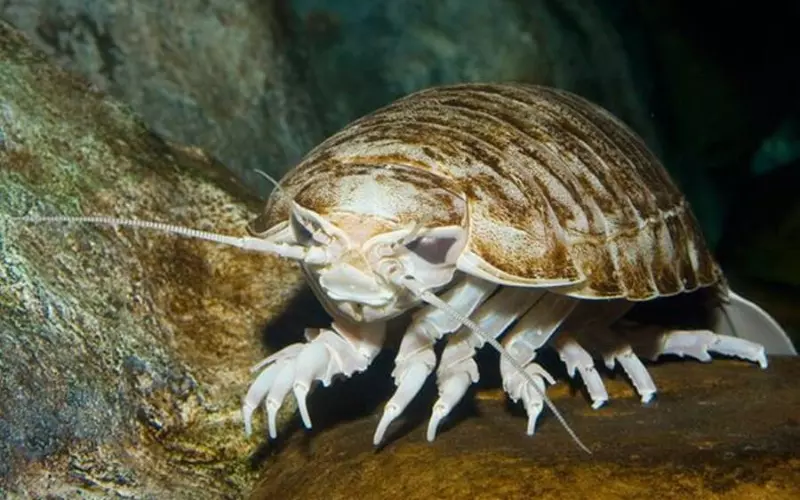
The giant isopod is one of the largest crustaceans in the world. It is commonly found in the deep sea, where it lives at great depths of up to 7,000 feet. This fascinating creature can grow quite big, with an average length of about 14 inches (35 centimetres) and around 3.5 pounds (1.6 kilograms). Imagine holding a big textbook in your hands – that’s about how large these remarkable animals can get!
One of the unique features of giant isopods is their tough and armoured exoskeleton, which helps protect them from predators and the immense pressure of the deep sea. They have a flat, oval-shaped body and a long, narrow tail called a prion. They also have 14 jointed legs, which they use for scavenging and moving across the ocean floor. Additionally, their large compound eyes allow them to see and sense their surroundings, even in the darkness where they live.
Giant isopods are scavengers and feed on decaying organic matter, like dead fish and whales that sink to the ocean floor. Due to the extreme depth at which they live, food can be scarce, so they have adapted to survive prolonged periods without eating. They have a slow metabolism, meaning their bodies do not require as much energy as animals living closer to the surface. This helps them conserve energy and survive in their deep-sea habitat, where resources are limited.
Giant isopods are incredible creatures adapted to thrive in the ocean’s depths. Their size, armour, and ability to survive in harsh conditions make them a fascinating species to learn about.
Habitat of Giant Isopod
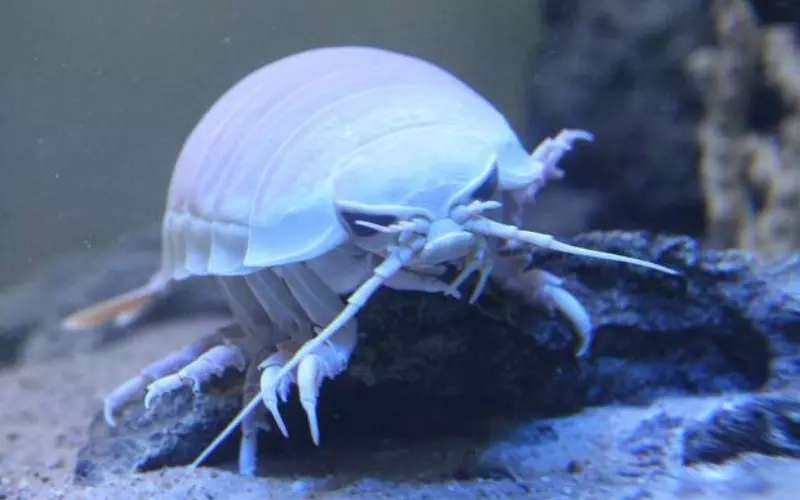
The giant isopod is a fascinating creature that lives deep in the oceans. It calls the seabed its home, residing at the bottom of the ocean floor. The giant isopod can be found in the depths of the Atlantic, Pacific, and Indian Oceans. It prefers a habitat where water pressure is high, and the temperature is cold.
The seabed is a dark and mysterious place, with little sunlight able to penetrate through the deep waters. This environment is perfect for the giant isopod, which prefers to hide and stay out of sight. It can often be found hiding under rocks, in crevices, or burrowing into the soft sediment of the ocean floor. The giant isopod is a skilled camouflage and uses its heavily armoured body to blend in with its surroundings, making it difficult for predators to spot.
The giant isopod is well-adapted to its habitat. It has a tough exoskeleton that protects its body from the high pressure of the deep sea. Its slow metabolism allows it to survive in the nutrient-poor environment of the seabed, where food can be scarce. It primarily feeds on dead animals that fall to the ocean floor, such as fish and whale carcasses. The giant isopod has evolved to withstand long periods without food, as it may not come across a meal for months.
The giant isopod lives in the deep ocean, making its habitat on the seabed. It prefers areas with high water pressure and cold temperatures. This unique creature is well-suited to its environment, using its tough exoskeleton and camouflage techniques to survive in the dark depths. Despite the challenges of finding food, the giant isopod has adapted to long periods without eating. Its fascinating habitat allows it to thrive in the mysterious world of the deep sea.
Evolution of Giant Isopod
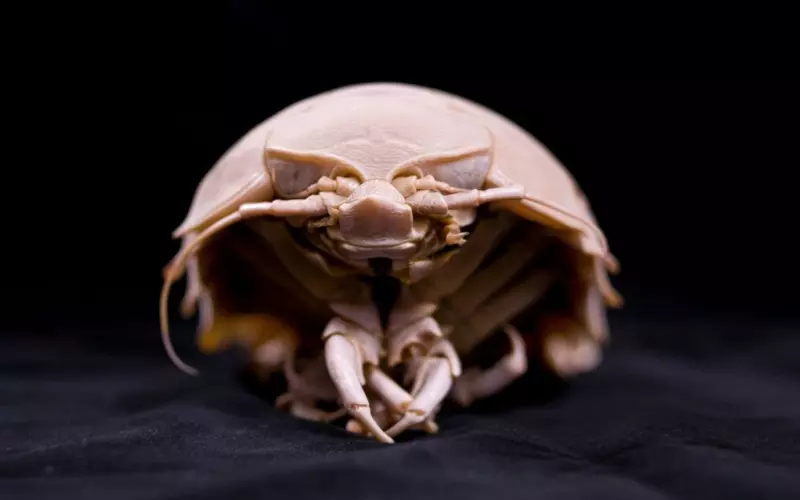
The giant isopod is a fascinating creature that has been around for a long time. Its evolution can be traced back to millions of years ago. These unique animals are crustaceans, which means they are related to crabs, lobsters, and shrimp. However, they have some distinct features that make them stand out.
In the early stages of their evolution, giant isopods looked different than they do today. They had smaller bodies and lived in shallow waters. As time passed, they adapted to survive in deeper parts of the ocean. This led to the development of their incredible size and unique appearance. They have a hard exoskeleton that helps protect them from predators and the pressure of the deep sea. Their flat bodies and long, spiky legs allow them to scavenge on the ocean floor, feeding on dead animals.
Over the years, giant isopods have survived by adapting to their environment. They have become masters of the deep ocean, where there is little light and much pressure. Although they may seem strange to us, they play an essential role in the ecosystem. They help clean up the ocean floor by consuming dead and decaying matter. Despite their prehistoric appearance, giant isopods are a fascinating example of how animals have adapted to different habitats.
Classification of Giant Isopod

The giant isopod, also known as Bathynomus giganteus, is a fascinating creature that belongs to the same family as woodlice and pill bugs. Despite its name, the giant isopod is not a true isopod but is more closely related to the shrimp and crab. This unique animal can be found in the deep waters of the Atlantic, Pacific, and Indian Oceans.
Regarding its classification, the giant isopod falls into the Kingdom Animalia, which includes all multicellular living organisms with specialized cells. Within the animal kingdom, it belongs to the Phylum Arthropoda, which comprises animals with an exoskeleton, segmented bodies, and jointed legs. This phylum includes insects, arachnids, and crustaceans like the giant isopod.
Further, the giant isopod is categorized in the Class Malacostraca. This class encompasses a large group of crustaceans that typically have a hardened exoskeleton and two pairs of antennae. Within this class, the giant isopod is placed in the Order Isopoda, which includes various marine and terrestrial species such as woodlice and pill bugs. However, the giant isopod stands out due to its remarkable size compared to its relatives.
The giant isopod is an intriguing animal classified within the Kingdom Animalia, Phylum Arthropoda, Class Malacostraca, and Order Isopoda. With its large size and distinctive features, the giant isopod captures the curiosity of many who encounter it. Exploring its classification helps us understand its relationship to other organisms and highlights its unique place in the animal kingdom.
Types of Giant Isopods

1. Appearance: Giant isopods are large and bizarre-looking crustaceans that resemble the common woodlouse but are much more extensive. They can grow up to 16 inches long and have armoured bodies, long antennae, and powerful claws.
2. Habitat: They are found in the deep sea, predominantly in the Atlantic and Pacific Oceans. Giant isopods inhabit the cold, dark depths, ranging from 550 to 7,020 feet below the surface.
3. Predatory Behavior: These creatures are opportunistic scavengers and predators. They mainly feed on dead or decaying matter that falls from the surface, but they are also known to catch live prey such as fish, squid, and other marine animals.
4. Slow Metabolism: Giant isopods have a prolonged metabolism, which allows them to survive on limited food sources. They can go for long periods without eating, as they are adapted to the low energy availability in the deep sea.
5. Defense Mechanisms: When threatened, giant isopods curl into a ball-like shape, protecting their vulnerable underside with their tough exoskeleton. They also have powerful claws that they can use to ward off potential predators or crush their prey.
6. Reproduction: Female giant isopods carry their eggs attached under their abdomen until they hatch. They can give birth to nearly 20,000 eggs at once, increasing their chances of survival in the harsh deep-sea environment.
7. Lifespan: Giant isopods have a relatively longer lifespan than other crustaceans. They can live up to 5-10 years in the wild, although some individuals have been known to live even longer in captivity.
8. Adaptations to High Pressure: Living at extreme depths exposes giant isopods to high-pressure environments. Their bodies are highly adapted to withstand these pressures with thick exoskeletons, flexible joints, and specialized internal structures.
9. Bioluminescence: Some species of giant isopods possess bioluminescent organs, which allow them to produce light. This adaptation is believed to be used for communication, attracting prey, or possibly as a defence mechanism in dark depths.
10. Human Interactions: Giant isopods have gained popularity among the public, and they are often exhibited in aquariums and museums or featured in documentaries. Their unique appearance and intriguing adaptations make them fascinating subjects of study for scientists exploring the mysteries of the deep sea.
Geographical Presence of Giant Isopod

The Giant Isopod is found in the deep sea regions of the world. These regions are located in the Atlantic, Pacific, and Indian Oceans. They are typically found at depths ranging from 550 to 7,020 feet (180 to 2,140 meters). The Giant Isopod is a fascinating creature that has adapted to survive in the extreme conditions of the deep sea.
However, Giant Isopods are not found in shallow waters or coastal regions. They require the deep sea’s dark, cold, and high-pressure environment to survive. These regions are far from the surface and often inaccessible to humans. This makes studying and observing these creatures quite challenging.
Giant Isopods have been discovered in various parts of the world, including off the coasts of Japan, New Zealand, Hawaii, and the Gulf of Mexico. They are believed to be more commonly found in cold waters, as their bodies are better suited to these temperatures. These unique creatures have dominated the depths of the oceans for millions of years, but due to their remote habitats, we still have much to learn about them.
Scientific Name of Giant Isopod
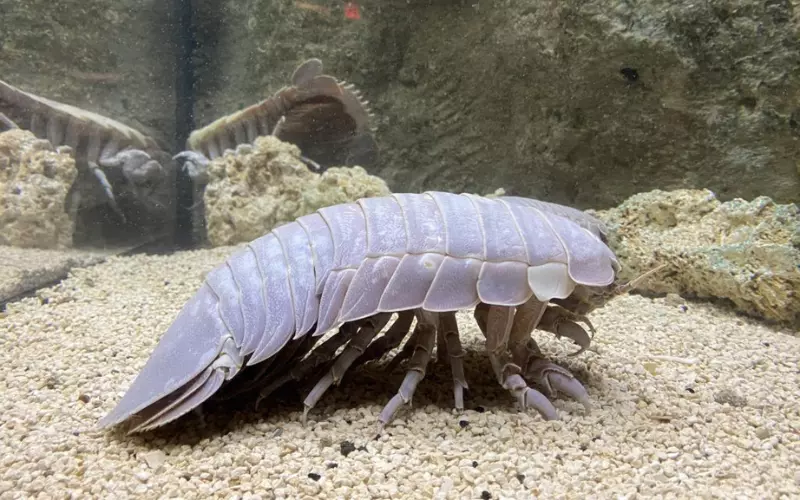
The scientific name of the giant isopod is Bathynomus giganteus. This fascinating creature is part of the crustacean family, which includes animals like crabs and lobsters. The giant isopod lives deep under the Atlantic Ocean and the Gulf of Mexico.
Bathynomus giganteus is an extraordinary creature that can grow up to a huge size, reaching lengths of around 14 inches or even longer! It has a hard exoskeleton or outer covering that helps protect its body. Its body is divided into segments, each with a pair of legs. These legs are used for walking and scavenging for food on the ocean floor.
This incredible species primarily feeds on dead animals that have fallen from above, such as fish, squid, and other ocean dwellers. It has a unique adaptation that allows it to survive for long periods without food, as it might not find a meal very often in its deep-sea habitat. Unlike many other creatures, the giant isopod can also endure the extreme pressures that exist in the deep ocean.
Bathynomus giganteus, or the giant isopod, is a remarkable creature living in the Atlantic Ocean and the Gulf of Mexico. This sea creature has adapted to its harsh environment with its enormous size, segmented body, and scavenging abilities. Its scientific name, Bathynomus giganteus, reflects its uniqueness and giant presence in the underwater world.
Diet of Giant Isopod

The giant isopod is a fascinating creature living deep in the ocean. It is a big bug-like animal which likes to eat a lot! Its diet mainly consists of dead animals or plant matter that fall to the ocean floor. You see, the giant isopod is a scavenger, which means it feeds on already dead things.
Since it lives in the dark and cold depths of the ocean, food can be scarce for the giant isopod. When it finds a dead fish or a squid, it uses its pungent and sharp jaws to tear off bits of food. Sometimes, it can even go without eating for a long time if insufficient food is available. This is because the giant isopod has a slow metabolism, which means it doesn’t need to eat as often as other animals.
Another interesting fact about the giant isopod’s diet is that it can also eat poop! Yes, you heard that right. It feeds on the waste materials that other animals produce. This might sound gross, but it is essential for the giant isopod to get nutrients and survive in its deep-sea environment.
The giant isopod has a specialized diet as a scavenger deep in the ocean. It mainly eats dead animals or plant matter that fall to the ocean floor. It can also feed on the waste materials produced by other animals. This unique diet helps the giant isopod survive in its dark and cold habitat, even when food is scarce.
Locomotion of Giant Isopod

The giant isopod is an incredible creature that moves fascinatingly. It uses its many legs to crawl along the ocean floor. The giant isopod can walk steadily and slowly with its strong and sturdy body.
When it is time to move, the giant isopod extends its legs and pushes against the ground. Its legs on both sides propel itself forward, creating a walking motion. This locomotion allows the giant isopod to explore its ocean habitat and search for food.
The giant isopod’s legs work together in a coordinated manner, making its movement efficient. It may not be the fastest creature in the ocean, but its unique way of walking helps it get from one place to another. Next time you imagine what it’s like to wander on the ocean floor, think about the giant isopod and how it uses its incredible locomotion skills.
Social and Sexual Behaviour of Giant Isopod

The giant isopod is a fascinating creature that lives deep in the ocean. It has interesting social and sexual behaviours that help it survive in its environment. Let’s learn about these behaviours!
Firstly, giant isopods are solitary creatures. This means that they prefer to live alone instead of in groups. They are often found in the deep sea, where little food and few other animals are around. This may be one reason why they choose to live alone. They can focus on finding food and avoiding predators without worrying about competition from other isopods.
Secondly, giant isopods have a unique way of reproducing. The females carry the eggs under their bellies until they hatch. This is similar to how some insects, like beetles, protect their eggs. Once the eggs hatch, the young isopods look like tiny versions of their parents. They then go off on their own to find food and survive.
Giant isopods are solitary creatures that prefer to live alone. They have a particular way of reproducing, with the females carrying the eggs until they hatch. These behaviours help them survive in the deep sea, where they live. So, next time you think about the ocean, remember the fantastic social and sexual behaviours of the giant isopod!
Reproduction and Lifecycle of Giant Isopod
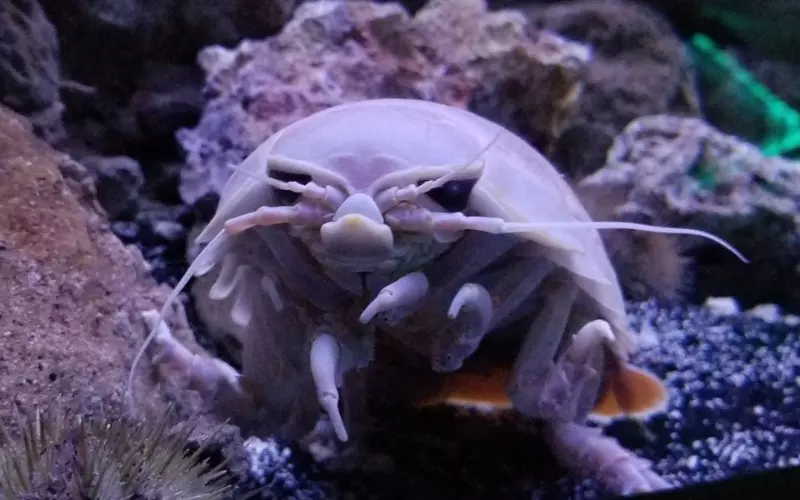
The giant isopod is a fascinating creature that undergoes an exciting process for reproduction and life cycle. These marine animals reproduce through direct development, which means they do not go through metamorphosis like other animals. Instead, they hatch from eggs as miniature versions of their parents.
Regarding reproduction, male and female giant isopods mate by transferring sperm from the male to the female. The female then carries the fertilized eggs in a special brood pouch on her belly. After some time, the eggs hatch, and the baby isopods emerge. These baby isopods look like tiny replicas of their parents.
The life cycle of the giant isopod is similar to that of other crustaceans. After hatching, the young isopods start their journey to become adults. They grow by moulting, which is shedding their hard exoskeleton. As they grow, the isopods undergo several moulting stages until they reach their full size.
The giant isopods reproduce through direct development, where the female carries fertilized eggs in a brood pouch until they hatch. The life cycle of these fascinating creatures involves moulting, where they shed their old exoskeletons to grow bigger. These processes help the giant isopods continue their life cycle in the vast oceans they inhabit.
Threats to Giant Isopod
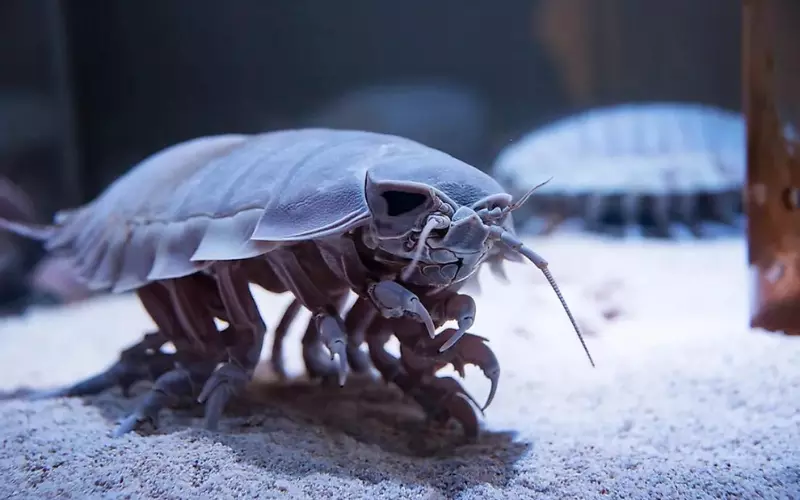
The giant isopod, a fascinating ocean-dwelling creature, faces severe environmental threats. One of the biggest threats comes from humans and their activities. Pollution, especially from chemicals and plastics, can harm the giant isopod. These pollutants can contaminate their food sources and habitats, making it difficult for them to survive and reproduce. We must be more mindful of our actions and reduce pollution to protect these amazing creatures.
Another threat to the giant isopod is overfishing. Many people catch them unintentionally while fishing for other species. This can result in a decline in their population numbers. Fishermen must be aware of their impact on these creatures and take measures to prevent accidental catches. Regulations and laws that protect the giant isopod can play a crucial role in conserving their population.
Climate change is also posing a threat to the giant isopod. Rising ocean temperatures and changing ocean chemistry can disrupt their natural habitat and food chains. It may affect the availability of food sources for the giant isopod, leading to a decline in their numbers. We need to take action against climate change, reducing carbon emissions and making sustainable choices to ensure the survival of these incredible creatures.
The giant isopod faces pollution, overfishing, and climate change threats. We must take responsibility for our actions and make changes in our daily lives to protect and preserve the habitat of these unique animals. By reducing pollution, practising sustainable fishing practices, and combating climate change, we can help ensure a safer future for the giant isopod and other marine species.
The population of Giant Isopod
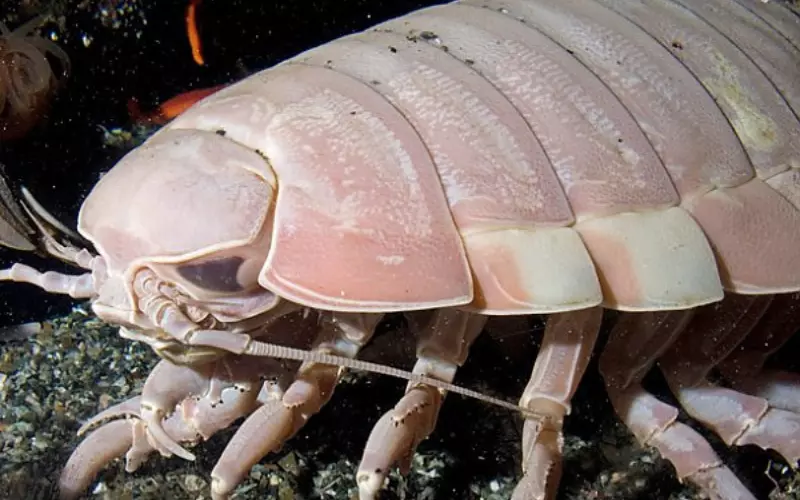
The population of giant isopod animals is complex to accurately determine because they live in the deep sea, far below the ocean’s surface. However, scientists estimate around 10,000 species of giant isopods worldwide. These marine creatures can grow quite large, reaching up to 16 inches.
Unfortunately, no evidence suggests that the giant isopod is extinct. They continue to thrive in the deep sea, where they scavenge for food and survive in the cold, dark waters. These fascinating creatures have evolved to withstand the extreme conditions of the deep sea and play an essential role in the ecosystem as decomposers.
Even though the population of giant isopods is not precisely known, scientists believe there are approximately 10,000 species of these deep-sea creatures. They have managed to survive and adapt to their harsh environment. As long as the deep sea remains undisturbed, we can hope for the continued existence of these peculiar animals.
Conclusion
The giant isopod is a fascinating creature that has captured the curiosity of scientists and nature enthusiasts. Found in the deep waters of the Atlantic Ocean, this remarkable animal has a long history dating back millions of years. Despite its intimidating appearance, the giant isopod is generally harmless and plays a vital role in its ecosystem.
Firstly, let’s talk about the size of these incredible animals. Giant isopods, growing up to 16 inches in length, are one of the largest crustaceans in the world. They have a fascinating appearance with their segmented bodies, multiple legs, and impressive exoskeleton. These features provide protection and help them survive in the cold and dark depths of the ocean.
Speaking of habitat, giant isopods call the deep waters of the Atlantic their home. They prefer depths ranging from 550 to 7,020 feet, where they scavenge on the ocean floor for food. Despite living in extreme conditions, these isopods have adapted well to their environment. They can withstand high pressure and scarce food resources, making them true warriors of the deep sea.
The giant isopod is an awe-inspiring creature in terms of its history and unique characteristics. These mighty creatures remind us of the diverse and mysterious world beneath the ocean’s surface. We should continue to explore and learn from these amazing animals to understand better and protect our fragile marine ecosystems.
Frequently Asked Questions about Giant Isopod (FAQ’s)
What is a giant isopod?
A giant isopod is a marine crustacean from the same family as pill bugs and sow bugs.
Where do giant isopods live?
Giant isopods can be found in the deep-sea waters of the Atlantic, Pacific, and Indian Oceans.
How big can giant isopods grow?
Giant isopods can grow up to 2.5 feet (76 centimetres) and weigh around 4.4 to 7.7 pounds (2 to 3.5 kilograms).
What do giant isopods eat?
Giant isopods are scavengers and feed on dead animals falling to the ocean floor.
How do giant isopods reproduce?
Giant isopods have a unique reproductive strategy called “brood pouching,” the female carries the eggs in a special brood pouch on her underside until they hatch.
What is the lifespan of a giant isopod?
The lifespan of a giant isopod is not precisely known, but it is estimated to be around 5 to 10 years in the wild.
Are giant isopods dangerous to humans?
No, giant isopods are not known to be dangerous to humans as they reside in intense waters, making interactions highly unlikely.
How do giant isopods protect themselves?
Giant isopods have a hard exoskeleton that provides protection. They can also curl up into a ball-like shape to further shield themselves.
Can giant isopods survive in captivity?
Yes, giant isopods can survive in captivity if provided with the appropriate conditions, such as a cold, dimly lit environment and a steady food supply.
Why are giant isopods often referred to as living fossils?
Giant isopods have retained many primitive characteristics over millions of years, resembling ancient forms of marine life, hence the term “living fossils.”
How deep can giant isopods be found?
Giant isopods are typically found in depths ranging from 550 to 7,020 feet (168 to 2,140 meters) below the ocean surface.
Do giant isopods have any predators?
While giant isopods are not commonly preyed upon due to their habitat, some deep-sea fish and other crustaceans are known to feed on them.
Can giant isopods survive low oxygen conditions?
Giant isopods have adaptations that allow them to survive in areas with lower oxygen levels, such as a slower metabolic rate and a reduced need for oxygen.
Are giant isopods bioluminescent?
No, giant isopods are not bioluminescent. They cannot produce light on their own.
Do giant isopods have any commercial or economic importance?
Giant isopods do not hold any commercial value, but they have gained popularity as exhibits in some public aquariums worldwide.

Hi there! I’m Morgan Gutierrez, and I love animals! I work as a Seasonal Animal Care Specialist at Brookfield Zoo and also teach people about animals, which is super fun. I studied at Valparaiso University in Lockport, Illinois, where I learned even more about these amazing creatures.
I’m not just about taking care of animals; I write articles about them, too! I explore and share many interesting animal stories, from cute kittens to giant elephants.
In the past, I’ve worked with veterinarians, helped with research, and even been an Animal Ambassador, bringing animals closer to people. Animals are my passion, and I enjoy helping others learn about them. So, if you ever want to know about animals, feel free to ask. I’ll explain it in a way that’s easy to understand, just like talking to a friend!

